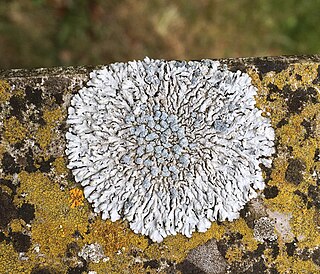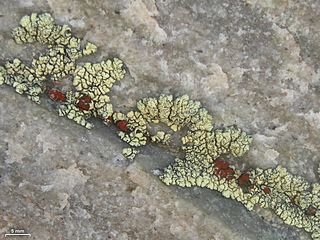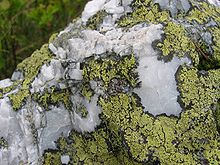
Lichenology is the branch of mycology that studies the lichens, symbiotic organisms made up of an intimate symbiotic association of a microscopic alga with a filamentous fungus. Lichens are chiefly characterized by this symbiosis.

A lichen is a composite organism that arises from algae or cyanobacteria living among filaments of multiple fungi species in a mutualistic relationship. Lichens are important actors in nutrient cycling and act as producers which many higher trophic feeders feed on, such as reindeer, gastropods, nematodes, mites, and springtails. Lichens have properties different from those of their component organisms. They come in many colors, sizes, and forms and are sometimes plant-like, but are not plants. They may have tiny, leafless branches (fruticose); flat leaf-like structures (foliose); grow crust-like, adhering tightly to a surface (substrate) like a thick coat of paint (crustose); have a powder-like appearance (leprose); or other growth forms.

Cladonia rangiferina, also known as reindeer cup lichen, reindeer lichen or grey reindeer lichen, is a light-colored fruticose, cup lichen species in the family Cladoniaceae. It grows in both hot and cold climates in well-drained, open environments. Found primarily in areas of alpine tundra, it is extremely cold-hardy.

In archaeology, palaeontology, and geomorphology, lichenometry is a geomorphic method of geochronologic dating that uses lichen growth to determine the age of exposed rock, based on a presumed specific rate of increase in radial size over time. Measuring the diameter of the largest lichen of a species on a rock surface can therefore be used to determine the length of time the rock has been exposed. Lichen can be preserved on old rock faces for up to 10,000 years, providing the maximum age limit of the technique, though it is most accurate when applied to surfaces that have been exposed for less than 1,000 years. Lichenometry is especially useful for dating surfaces less than 500 years old, as radiocarbon dating techniques are less accurate over this period. The lichens most commonly used for lichenometry are those of the genera Rhizocarpon and Xanthoria. The measured growth rates of R. geographicum tends to fall within the range of 0.9–0.3 millimeter per year, depending on several factors, including the size of the lichen patch.
The Holocene glacial retreat is a geographical phenomenon that involved the global retreat of glaciers (deglaciation) that previously had advanced during the Last Glacial Maximum. Ice sheet retreat initiated ca. 19,000 years ago and accelerated after ca. 15,000 years ago. The Holocene, starting with abrupt warming 11,700 years ago, resulted in rapid melting of the remaining ice sheets of North America and Europe.

Rusavskia elegans, commonly known as the elegant sunburst lichen, is a lichenized species of fungus in the genus Rusavskia, family Teloschistaceae. Recognized by its bright orange or red pigmentation, this species grows on rocks, often near bird or rodent perches. It has a circumpolar and alpine distribution. It was one of the first lichens to be used for the rock-face dating method known as lichenometry.

Rhizocarpon is a genus of crustose, saxicolous, lecideoid lichens in the family Rhizocarpaceae. The genus is common in arctic-alpine environments, but also occurs throughout temperate, subtropical, and even tropical regions. They are commonly known as map lichens because of the prothallus forming border-like bands between colonies in some species, like the common map lichen.

Crustose lichens are lichens that form a crust which strongly adheres to the substrate, making separation from the substrate impossible without destruction. The basic structure of crustose lichens consists of a cortex layer, an algal layer, and a medulla. The upper cortex layer is differentiated and is usually pigmented. The algal layer lies beneath the cortex. The medulla fastens the lichen to the substrate and is made up of fungal hyphae. The surface of crustose lichens is characterized by branching cracks that periodically close in response to climatic variations such as alternate wetting and drying regimes.
Placopsis perrugosa is a saxicolous (rock-dwelling), placodioid lichen in the family Trapeliaceae. It was formally described as a new species in 1867 by Finnish lichenologist William Nylander, originally as a member of the genus Lecanora.

Cetraria aculeata or the spiny Iceland lichen is a dark brown to black fruticose, soil Iceland lichen from the family Parmeliaceae. The species was first described by German naturalist Johann Christian Daniel Edler von Schreber in 1771 under the name of Lichen aculeatus. Later on, Erik Acharius, the "father of lichenology" gave it a name of Cornicularia aculeata, which lately has been changed to Coelocaulon aculeatum. Finally, the taxonomic revision of Ingvar Kärnefelt and colleagues assigned the species to the genus Cetraria.

Physcia caesia, known colloquially as blue-gray rosette lichen and powder-back lichen, is a species of foliose lichenized fungus. First described by Georg Franz Hoffmann in 1784, it is common across much of Europe, North America and New Zealand, and more patchily distributed in South America, Asia, Australia and Antarctica. There are 2 subspecies: P. c. caesia and P. c. ventosa, as well as a number of distinct forms and varieties. Molecular studies suggest that the species as currently defined may be polyphyletic. It is typically pale gray shading to darker gray in the center, and grows in a small rosette, usually some 2–3 cm (0.79–1.18 in) across at maturity. It only rarely has apothecia, instead reproducing most often vegetatively via soredia, which are piled in round blue-gray mounds across the thallus's upper surface. It grows most often on rock—principally calcareous, but also basaltic and siliceous—and also occurs on bone, bark and soil. It is nitrophilic and is particularly common on substrates where birds perch.
Roland Ernst Beschel was an Austrian botanist, lichenologist, professor, and herbarium director, known for his famous doctoral thesis and subsequent research on lichenometry.

Lecanora polytropa, commonly known as the granite-speck rim lichen, is a species of saxicolous lichen in the family Parmeliaceae. A small, inconspicuous species that grows in the cracks of rock surfaces, it has a cosmopolitan distribution and has been recorded on all continents, including Antarctica.

Muellerella ventosicola is a species of lichenicolous fungus in the family Verrucariaceae. It shows preference to growing on species of the genus Rhizocarpon but can also associate with other genera.

Muellerella pygmaea is a species of lichenicolous fungus in the family Verrucariaceae. It has a cosmopolitan distribution in Arctic-alpine areas and grows on the thallus and apothecia of a number of hosts.

Sporastatia is a genus of crustose lichens in the family Sporastatiaceae. It has four species. Sporastatia lichens are long-lived species that grow on siliceous or weakly calcareous rocks in arctic and alpine locales.
Lecanora lojkahugoi is a species of saxicolous (rock-dwelling) crustose lichen in the family Lecanoraceae. It is found in the Russian Far East and in South Korea.

Pyrenodesmia is a genus of lichen-forming fungi in the family Teloschistaceae. The genus currently includes 23 recognized species but is believed to contain many more unnamed taxa. The genus was circumscribed in 1852 by Italian lichenologist Abramo Bartolommeo Massalongo. It is characterised by the complete absence of anthraquinones and the presence of Sedifolia-gray pigments in both the thallus and apothecia. These lichens are typically found in calcareous outcrops in the Northern Hemisphere, with biodiversity centres in the Mediterranean basin, Central Asia, and arid regions of western North America.
Schaereria porpidioides is a species of saxicolous (rock-dwelling), crustose lichen in the family Schaereriaceae. It is found in the Falkland Islands.

Erichansenia epithallina is a species of saxicolous (rock-dwelling), crustose lichen in the family Teloschistaceae. It is also a lichenicolous lichen species, meaning that it grows on other lichens. Many host genera have been recorded. It occurs in Europe and North America, including Arctic regions.















